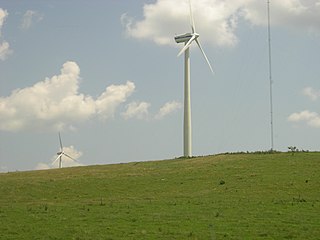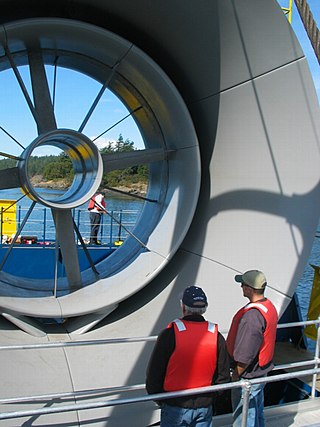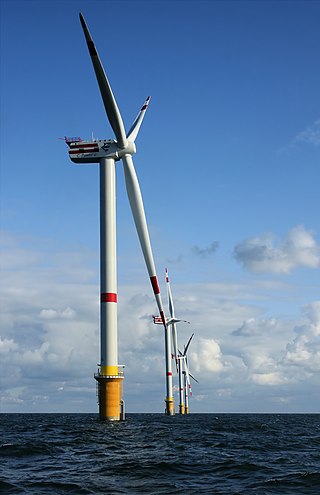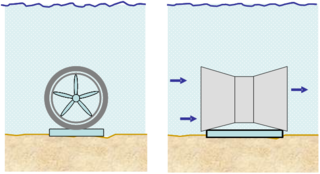
Tidal power or tidal energy is harnessed by converting energy from tides into useful forms of power, mainly electricity using various methods.

Hydroelectricity, or hydroelectric power, is electricity generated from hydropower. Hydropower supplies one sixth of the world's electricity, almost 4500 TWh in 2020, which is more than all other renewable sources combined and also more than nuclear power. Hydropower can provide large amounts of low-carbon electricity on demand, making it a key element for creating secure and clean electricity supply systems. A hydroelectric power station that has a dam and reservoir is a flexible source, since the amount of electricity produced can be increased or decreased in seconds or minutes in response to varying electricity demand. Once a hydroelectric complex is constructed, it produces no direct waste, and almost always emits considerably less greenhouse gas than fossil fuel-powered energy plants. However, when constructed in lowland rainforest areas, where part of the forest is inundated, substantial amounts of greenhouse gases may be emitted.

Race Rocks Ecological Reserve is a BC Parks ecological reserve off the southern tip of Vancouver Island in the Strait of Juan de Fuca in Metchosin, British Columbia, Canada.
Marine currents can carry large amounts of water, largely driven by the tides, which are a consequence of the gravitational effects of the planetary motion of the Earth, the Moon and the Sun. Augmented flow velocities can be found where the underwater topography in straits between islands and the mainland or in shallows around headlands plays a major role in enhancing the flow velocities, resulting in appreciable kinetic energy. The Sun acts as the primary driving force, causing winds and temperature differences. Because there are only small fluctuations in current speed and stream location with minimal changes in direction, ocean currents may be suitable locations for deploying energy extraction devices such as turbines. Other effects such as regional differences in temperature and salinity and the Coriolis effect due to the rotation of the earth are also major influences. The kinetic energy of marine currents can be converted in much the same way that a wind turbine extracts energy from the wind, using various types of open-flow rotors.

Wind power is one of the main renewable energy sources in the world. In Australia alone wind power contributed 10% of Australia's total electricity supply in 2020, and made up to 37.5% of its renewable energy supply. Wind resource testing conditions in Australia are optimum, as abundant wind resources are located close to residential areas in the southern parts of the country and on the slopes of the Great Dividing Range in the east.

The production of renewable energy in Scotland is a topic that came to the fore in technical, economic, and political terms during the opening years of the 21st century. The natural resource base for renewable energy is high by European, and even global standards, with the most important potential sources being wind, wave, and tide. Renewables generate almost all of Scotland's electricity, mostly from the country's wind power.
The Siemens Energy Sector was one of the four sectors of German industrial conglomerate Siemens. Founded on January 1, 2009, it generated and delivered power from numerous sources including the extraction, conversion and transport of oil and natural gas in addition to renewable and alternative energy sources. As of October 1, 2014, the sector level has been eliminated, including the Siemens Energy Sector.

The European Marine Energy Centre (EMEC) Ltd is a UKAS accredited test and research center focusing on wave and tidal power development based in the Orkney Islands, UK. The centre provides developers with the opportunity to test full-scale grid-connected prototype devices in unrivalled wave and tidal conditions.

The Madison Wind Farm is a power generation plant located in the town of Madison, New York. Constructed in 1999-2000, it was the first wind farm completed in New York state and the first merchant wind farm in the country. The power plant consists of seven Vestas V66-1.65 MW wind turbines, generating enough energy to power up to 10,000 homes. The Vestas V66-1.65 MW wind turbines have a hub height of 67m and a 66m rotor diameter totally 100m to the top of the rotor

SeaGen was the world's first large scale commercial tidal stream generator. It was four times more powerful than any other tidal stream generator in the world at the time of installation. It was successfully decommissioned by SIMEC Atlantis Energy Limited in summer 2019, having exported 11.6GWh to the grid since 2008.
Marine Current Turbines Ltd (MCT), is a United Kingdom-based company which is developing tidal stream generators. It is owned by the German automation company, Siemens.

The shrouded tidal turbine is an emerging tidal stream technology that has a turbine enclosed in a venturi shaped shroud or duct (ventuduct), producing a sub atmosphere of low pressure behind the turbine. The venturi shrouded turbine is not subject to the Betz limit and allows the turbine to operate at higher efficiencies than the turbine alone by increasing the volume of the flow over the turbine. Claimed improvements vary, from 1.15 to 4 times higher power output than the same turbine minus the shroud. The Betz limit of 59.3% conversion efficiency for a turbine in an open flow still applies, but is applied to the much larger shroud cross-section rather than the small turbine cross-section.

A wind turbine is a device that converts the kinetic energy of wind into electrical energy. As of 2020, hundreds of thousands of large turbines, in installations known as wind farms, were generating over 650 gigawatts of power, with 60 GW added each year. Wind turbines are an increasingly important source of intermittent renewable energy, and are used in many countries to lower energy costs and reduce reliance on fossil fuels. One study claimed that, as of 2009, wind had the "lowest relative greenhouse gas emissions, the least water consumption demands and the most favorable social impacts" compared to photovoltaic, hydro, geothermal, coal and gas energy sources.

As of 2019, renewable energy technologies provide about 17.3% of Canada's total primary energy supply. For electricity renewables provide 67%, with 15% from nuclear and 18% from hydrocarbons.
Low-head hydropower refers to the development of hydroelectric power where the head is typically less than 20 metres, although precise definitions vary. Head is the vertical height measured between the hydro intake water level and the water level at the point of discharge. Using only a low head drop in a river or tidal flows to create electricity may provide a renewable energy source that will have a minimal impact on the environment. Since the generated power is a function of the head these systems are typically classed as small-scale hydropower, which have an installed capacity of less than 5MW.

Marine energy or marine power refers to the energy carried by ocean waves, tides, salinity, and ocean temperature differences. The movement of water in the world's oceans creates a vast store of kinetic energy, or energy in motion. Some of this energy can be harnessed to generate electricity to power homes, transport and industries.

A tidal farm is a group of multiple tidal stream generators assembled in the same location used for production of electric power, similar to that of a wind farm. The low-voltage powerlines from the individual units are then connected to a substation, where the voltage is stepped up with the use of a transformer for distribution through a high voltage transmission system.

A tidal stream generator, often referred to as a tidal energy converter (TEC), is a machine that extracts energy from moving masses of water, in particular tides, although the term is often used in reference to machines designed to extract energy from run of river or tidal estuarine sites. Certain types of these machines function very much like underwater wind turbines, and are thus often referred to as tidal turbines. They were first conceived in the 1970s during the oil crisis.

Variable renewable energy (VRE) or intermittent renewable energy sources (IRES) are renewable energy sources that are not dispatchable due to their fluctuating nature, such as wind power and solar power, as opposed to controllable renewable energy sources, such as dammed hydroelectricity or biomass, or relatively constant sources, such as geothermal power.
















